How about a little Otis Redding? Also bringing back the a cappella!
Take Notes
Monday, July 18, 2011
Friday, July 1, 2011
Lesson #5 - Extracting Chords From a Major Scale
And here we are! The lesson you all (read: I) have been waiting for! Let me just reiterate some keys aspects about chords (specifically, triads) and the major scale before I throw you into the deep end.
Triads
C - D - E - F - G - A - B - C
Scales with flats:
F Major (1 flat)
F - G - A - Bb - C - D - E - F
Bb Major (2 flats)
Bb - C - D - Eb - F - G - A - Bb
Eb Major (3 flats)
Eb - F - G - Ab - Bb - C - D - Eb
Ab Major (4 flats)
Ab - Bb - C - Db - Eb - F - G - Ab
Db Major (5 flats)
Db - Eb - F - Gb - Ab - Bb - C - Db
Scales with sharps:
G Major (1 sharp)
G - A - B - C - D - E - F# - G
D Major (2 sharps)
D - E - F# - G - A - B - C# - D
A Major (3 sharps)
A - B - C# - D - E - F# - G# - A
E Major (4 sharps)
E - F# - G# - A - B - C# - D# - E
B Major (5 sharps)
B - C# - D# - E - F# - G# - A# - B
F# Major (6 sharps)
F# - G# - A# - B - C# - D# - E# - F#
Memorize all of that? Good. Because here comes the fun stuff.
Chords are created from thirds. However, the major scale consists of notes all separated by seconds. C to D is a second, D to E is a second, E to F is a second, and so on. Nevermind whether they are minor or major. Just know that they are all seconds.
C D E F G A B C
SECONDS
Since triads contain three notes separated by thirds, and not seconds, let's find a chord from the C major scale. And to make things easy, let's start on C. So what we do is start with our root (C), skip D, then go to our next note (E), skip the F, and then find our last note (G)
C __ E __ G
C-E-G? Why, that's a C major triad! And we got that by building a chord on the first scale degree. Go ahead, play it yourself (note: You can play the virtual keyboard using your computer keyboard. F and G on the computer play the notes F and G respectively, and everything else lines up accordingly. Try it out for yourself)
So what does this have to do with anything? Why are we making chords from scales? How will that help us play other people's songs or create or own?
Well, the big deal is that most songs with which we are familiar in Western culture are based around one key. That is to say that when an artist writes a song, most if not all of the notes in that song will belong to one key signature. If someone writes a song in the key of G, then probably at least 98% of the notes will be one of the following:
G A B C D E F# G
i.e., the notes of a G major scale.
The thing is, no one wants to hear all of those notes played at the same time. While the sequence of notes in a scale may sound good, playing them simultaneously will sound like garbage. Certain combinations of notes sound great together, and other combinations just suck. So to keep things under control within a song, we have harmony. Simply put, different sections of a song will be based around different chords. But whatever chord it is, it will likely be a chord that's consistent with the key signature. Take a listen to this song medley:
If you listen closely, you'll notice that the chord on the piano changes about every 2 seconds. The chords being played are as followed:
A minor: A - C - E
F major: F - A - C
C major: C - E - G
G major: G - B - D
The only major scale that contains all of these notes is C major. So we can probably assume - nay, I am TELLING YOU - that the songs in this medley are in the key of C!!.
The progression of A minor - F major - C major - G major is a 6-4-1-5 in the key of C. Remember, we created a C major chord by building a chord on the first scale degree of C major (i.e., the first note of the C major scale). That is the 1 in this progression. Let's double-check the others to make sure they're right.
6
What is the sixth scale degree of C major? Let's count up the scale:
C - 1
D - 2
E - 3
F - 4
G - 5
A - 6 BAM!
Now what do we get when we build a triad on that note?
A B C D E
A - C - E
A to C is a minor third. C to E is a major third. Which means the 6 chord of C major is an A minor triad!
4
What is the fourth scale degree of C major? Let's count up the scale:
C - 1
D - 2
E - 3
F - 4 SHAZAM!
Now what do we get when we build a triad on that note?
F G A B C
F - A - C
F to A is a major third. A to C is a minor third. Which means the 4 chord of C major is an F major triad!
5
What is the fifth scale degree of C major? Let's count up the scale:
C - 1
D - 2
E - 3
F - 4
G - 5 BAZINGA!
Now what do we get when we build a triad on that note?
G A B C D
G - B - D
G to B is a major third. B to D is a minor third. Which means the 5 chord of C major is a G major triad!
To avoid having to do that for every note in the scale, here's a handy chart:
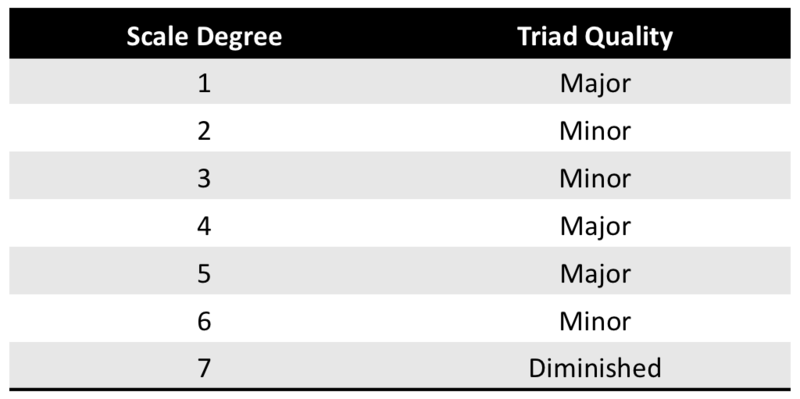
Don't worry about diminished for now. Only weird people use that anyway.
So how do you feel? Honestly, if you've never encountered this stuff before and you understood everything here, then I'm very impressed. Actually I don't believe you. Regardless, like everything else, it takes a lot of repetition and practice to really get it. And even then, a lot of people really only master this stuff in a few keys. Sure, I could play you a 6-4-1-5 in F# major, but it'll take me a little longer to remember what chords to play. So don't worry if you don't immediately perfect this in every key. It's a lot to take in.
Triads
- A major triad contains an interval of a major third between the first and second notes and a minor third between the second and third notes (e.g., C-E-G)
- A minor triad contains an interval of a minor third between the root and second notes and a major third between the second and third notes(e.g., C-Eb-G)
- The major scale in any key consists of seven unique notes
- The intervals of the major scale, in order, are as follows:
- Whole Step
- Whole Step
- Half Step
- Whole Step
- Whole Step
- Whole Step
- Half Step
- Finally, because I'm still such a nice guy, I'm going to give you all twelve major scales in their most common spellings
C - D - E - F - G - A - B - C
Scales with flats:
F Major (1 flat)
F - G - A - Bb - C - D - E - F
Bb Major (2 flats)
Bb - C - D - Eb - F - G - A - Bb
Eb Major (3 flats)
Eb - F - G - Ab - Bb - C - D - Eb
Ab Major (4 flats)
Ab - Bb - C - Db - Eb - F - G - Ab
Db Major (5 flats)
Db - Eb - F - Gb - Ab - Bb - C - Db
Scales with sharps:
G Major (1 sharp)
G - A - B - C - D - E - F# - G
D Major (2 sharps)
D - E - F# - G - A - B - C# - D
A Major (3 sharps)
A - B - C# - D - E - F# - G# - A
E Major (4 sharps)
E - F# - G# - A - B - C# - D# - E
B Major (5 sharps)
B - C# - D# - E - F# - G# - A# - B
F# Major (6 sharps)
F# - G# - A# - B - C# - D# - E# - F#
Memorize all of that? Good. Because here comes the fun stuff.
Chords are created from thirds. However, the major scale consists of notes all separated by seconds. C to D is a second, D to E is a second, E to F is a second, and so on. Nevermind whether they are minor or major. Just know that they are all seconds.
C D E F G A B C
SECONDS
Since triads contain three notes separated by thirds, and not seconds, let's find a chord from the C major scale. And to make things easy, let's start on C. So what we do is start with our root (C), skip D, then go to our next note (E), skip the F, and then find our last note (G)
C __ E __ G
C-E-G? Why, that's a C major triad! And we got that by building a chord on the first scale degree. Go ahead, play it yourself (note: You can play the virtual keyboard using your computer keyboard. F and G on the computer play the notes F and G respectively, and everything else lines up accordingly. Try it out for yourself)
So what does this have to do with anything? Why are we making chords from scales? How will that help us play other people's songs or create or own?
Well, the big deal is that most songs with which we are familiar in Western culture are based around one key. That is to say that when an artist writes a song, most if not all of the notes in that song will belong to one key signature. If someone writes a song in the key of G, then probably at least 98% of the notes will be one of the following:
G A B C D E F# G
i.e., the notes of a G major scale.
The thing is, no one wants to hear all of those notes played at the same time. While the sequence of notes in a scale may sound good, playing them simultaneously will sound like garbage. Certain combinations of notes sound great together, and other combinations just suck. So to keep things under control within a song, we have harmony. Simply put, different sections of a song will be based around different chords. But whatever chord it is, it will likely be a chord that's consistent with the key signature. Take a listen to this song medley:
If you listen closely, you'll notice that the chord on the piano changes about every 2 seconds. The chords being played are as followed:
A minor: A - C - E
F major: F - A - C
C major: C - E - G
G major: G - B - D
The only major scale that contains all of these notes is C major. So we can probably assume - nay, I am TELLING YOU - that the songs in this medley are in the key of C!!.
The progression of A minor - F major - C major - G major is a 6-4-1-5 in the key of C. Remember, we created a C major chord by building a chord on the first scale degree of C major (i.e., the first note of the C major scale). That is the 1 in this progression. Let's double-check the others to make sure they're right.
6
What is the sixth scale degree of C major? Let's count up the scale:
C - 1
D - 2
E - 3
F - 4
G - 5
A - 6 BAM!
Now what do we get when we build a triad on that note?
A B C D E
A - C - E
A to C is a minor third. C to E is a major third. Which means the 6 chord of C major is an A minor triad!
4
What is the fourth scale degree of C major? Let's count up the scale:
C - 1
D - 2
E - 3
F - 4 SHAZAM!
Now what do we get when we build a triad on that note?
F G A B C
F - A - C
F to A is a major third. A to C is a minor third. Which means the 4 chord of C major is an F major triad!
5
What is the fifth scale degree of C major? Let's count up the scale:
C - 1
D - 2
E - 3
F - 4
G - 5 BAZINGA!
Now what do we get when we build a triad on that note?
G A B C D
G - B - D
G to B is a major third. B to D is a minor third. Which means the 5 chord of C major is a G major triad!
To avoid having to do that for every note in the scale, here's a handy chart:

Don't worry about diminished for now. Only weird people use that anyway.
So how do you feel? Honestly, if you've never encountered this stuff before and you understood everything here, then I'm very impressed. Actually I don't believe you. Regardless, like everything else, it takes a lot of repetition and practice to really get it. And even then, a lot of people really only master this stuff in a few keys. Sure, I could play you a 6-4-1-5 in F# major, but it'll take me a little longer to remember what chords to play. So don't worry if you don't immediately perfect this in every key. It's a lot to take in.
Tuesday, June 28, 2011
Lesson #4 - Scales (Major and Minor)
With chords discussed in a previous post eons ago, now would be a good time to delve into the two common types of scales.
Major Scales
If you've heard the Do-Re-Mi scale, then you already know what a major scale is, even if you haven't referred to it by that name before. For simplicity's sake, let's look at the notes of a C major scale:
C (Do)
D (Re)
E (Mi)
F (Fa)
G (So)
A (La)
B (Ti)
C (Do)
If you want to open up the Virtual Keyboard again and play those notes, you'll notice that the C scale consists of all white keys. Also remember the difference between whole steps and half-steps:

- The distance between two notes is a half step if there are no keys in between them (i.e., they're one semitone apart)
- The distance between two notes is a whole step if there is one key (either white or black) between them (i.e., they're two semitones apart)
Therefore, the major scale consists of the following intervals:
Whole Step - Whole Step - Half Step - Whole Step - Whole Step - Whole Step - Half Step
But don't take my word for it. Take this picture's:
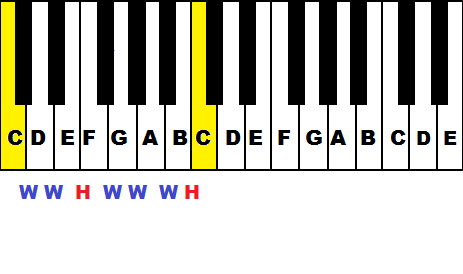
See that? The picture doesn't lie.
So what if you wanted to play the same type of scale, but starting on D? Well, grab your piano, keyboard, or Virtual Keyboard and play the following notes:
D E F# G A B C# D
Even though the notes are different from those of the C major scale, you can probably tell that the two scales sound very similar. That's because the intervals are the same from the first to last note. Because of this, you can change the root of any scale or chord, yet retain the same quality (i.e. minor stays minor, major stays major, etc) by moving all of the notes the same amount in the same direction!
Take, for example, the two major scales I just showed you. To transform a C major scale into a D major scale, simply look at the distance between the notes C and D. D is one whole step above C. Therefore, move every note of the C major scale up a whole step. Voila!
Minor Scales
Now that I've already gone over the major scale and changing keys, the rest shouldn't take long.
The formula for a minor scale is the following:
Whole Step - Half Step - Whole Step - Whole Step - Half Step - Whole Step - Whole Step
Now, which minor scale should I show you? To keep things simple, let's once again go with the one with all white keys. Is that C? Nope! It's A:
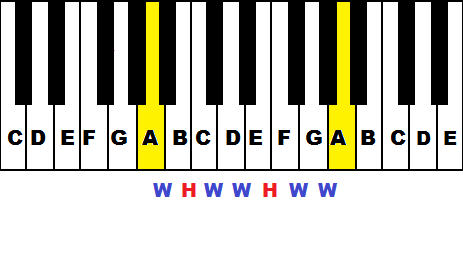
That's right! C major and A minor have the same notes! Which means that the two are related:
A is the relative minor of C
Likewise, C is the relative major of A
Play both scales and listen to how different they sound.
This handy nugget of information can save us a lot of time. If you want to learn all 12 major and minor scales, you can shorten the process by just remembering all of the major scales (still a lot of work, I know). Once you do that, you can figure out, for example, the G minor scale by doing the following:
- Count up 3 semitones from G. That gives us Bb
- Figure out what notes are in the Bb major scale (I'll help you out. It's Bb - C - D - Eb - F - G - A - Bb
- Play that very scale, but starting on G. Therefore, you'll be playing G - A - Bb - C - D - Eb - F - G
If you've never learned scales before, this is probably a lot to take in at once. Fortunately, there aren't really any tricks. All it takes is a lot of practice and repetition to let this stuff sink in.
Next lesson, I'll be getting to the good stuff. I keep mentioning the infamous 6-4-1-5 progression without explaining in too much detail what that means. For now, I'll just say that the numbers themselves refer partially to the scale degree of the major scale (i.e. the 6th note in a major scale, then the 4th note, then the 1st, then the 5th). See if you can figure out the rest before the next entry!
Major Scales
If you've heard the Do-Re-Mi scale, then you already know what a major scale is, even if you haven't referred to it by that name before. For simplicity's sake, let's look at the notes of a C major scale:
C (Do)
D (Re)
E (Mi)
F (Fa)
G (So)
A (La)
B (Ti)
C (Do)
If you want to open up the Virtual Keyboard again and play those notes, you'll notice that the C scale consists of all white keys. Also remember the difference between whole steps and half-steps:

- The distance between two notes is a half step if there are no keys in between them (i.e., they're one semitone apart)
- The distance between two notes is a whole step if there is one key (either white or black) between them (i.e., they're two semitones apart)
Therefore, the major scale consists of the following intervals:
Whole Step - Whole Step - Half Step - Whole Step - Whole Step - Whole Step - Half Step
But don't take my word for it. Take this picture's:

See that? The picture doesn't lie.
So what if you wanted to play the same type of scale, but starting on D? Well, grab your piano, keyboard, or Virtual Keyboard and play the following notes:
D E F# G A B C# D
Even though the notes are different from those of the C major scale, you can probably tell that the two scales sound very similar. That's because the intervals are the same from the first to last note. Because of this, you can change the root of any scale or chord, yet retain the same quality (i.e. minor stays minor, major stays major, etc) by moving all of the notes the same amount in the same direction!
Take, for example, the two major scales I just showed you. To transform a C major scale into a D major scale, simply look at the distance between the notes C and D. D is one whole step above C. Therefore, move every note of the C major scale up a whole step. Voila!
Minor Scales
Now that I've already gone over the major scale and changing keys, the rest shouldn't take long.
The formula for a minor scale is the following:
Whole Step - Half Step - Whole Step - Whole Step - Half Step - Whole Step - Whole Step
Now, which minor scale should I show you? To keep things simple, let's once again go with the one with all white keys. Is that C? Nope! It's A:

That's right! C major and A minor have the same notes! Which means that the two are related:
A is the relative minor of C
Likewise, C is the relative major of A
Play both scales and listen to how different they sound.
This handy nugget of information can save us a lot of time. If you want to learn all 12 major and minor scales, you can shorten the process by just remembering all of the major scales (still a lot of work, I know). Once you do that, you can figure out, for example, the G minor scale by doing the following:
- Count up 3 semitones from G. That gives us Bb
- Figure out what notes are in the Bb major scale (I'll help you out. It's Bb - C - D - Eb - F - G - A - Bb
- Play that very scale, but starting on G. Therefore, you'll be playing G - A - Bb - C - D - Eb - F - G
If you've never learned scales before, this is probably a lot to take in at once. Fortunately, there aren't really any tricks. All it takes is a lot of practice and repetition to let this stuff sink in.
Next lesson, I'll be getting to the good stuff. I keep mentioning the infamous 6-4-1-5 progression without explaining in too much detail what that means. For now, I'll just say that the numbers themselves refer partially to the scale degree of the major scale (i.e. the 6th note in a major scale, then the 4th note, then the 1st, then the 5th). See if you can figure out the rest before the next entry!
My Own 4 Chords Medley
No matter how many of these are done, we're never going to pinpoint every single song that uses a 6-4-1-5 (or 1-5-6-4) progression. More on what this actually means in another post. But for now, enjoy the 13 (ish?) tune mashup ala Axis of Awesome!
Wednesday, March 23, 2011
Lesson #3 - Chords (Major and Minor Triads)
Because major and minor chords make up about 80% of pop music. Everything else can be seen as slight additions/revisions to those chords. For now, I'll discuss major and minor triads, which are 3-note chords.
Major Triads
Remember major 3rd and minor 3rd intervals? You better, because those are essentially the foundation of chord structures. To form a major triad on any one note (for example, C), we first go up a major third from the root. C is the root, so going up a major third gives you E
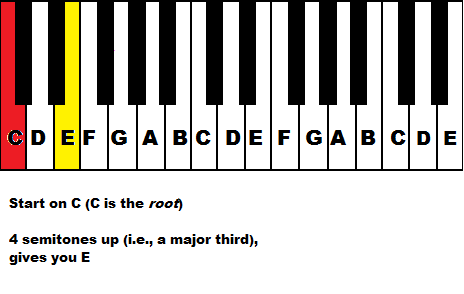
That covers two notes of the triad. To get the last note, start on the second note (the E in this case), and go up a minor third
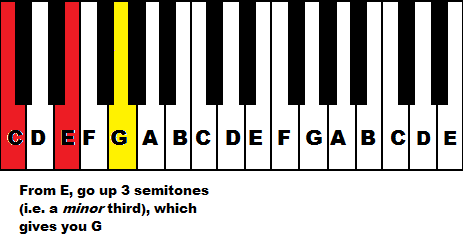
In conclusion:
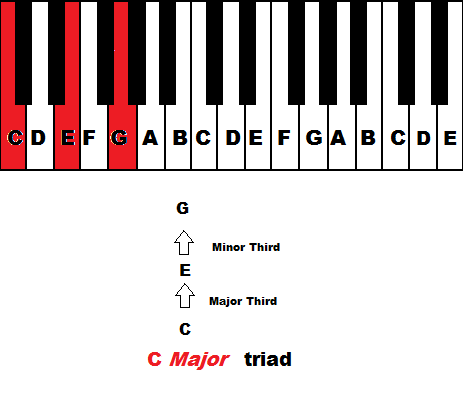
As always, I encourage you to play out the notes so you can hear what the chords sound like. You can play multiple notes at one time using this virtual keyboard.
Since I'm such a nice guy, rather than making you figure out each major chord on your own, I'll just list them out. The first note of each triad is the name of the chord (e.g., F A C is an F major triad). Also remember that black keys can have two different note names (e.g., Bb and A# are the same, as is D# and Eb).
C E G
F A C
Bb D F
Eb G Bb
Ab C Eb
Db F Ab
F# A# C#
B D# F#
E G# B
A C# E
D F# A
G B D
________________________________________________________________
Got all that? I hope so. Because now it's time for minor triads!
________________________________________________________________
Minor Triads
There are a few ways in which you can think about minor triads. The "proper" way is to think about the intervals. Whereas a major triad contains a major third, and THEN a minor, a minor triad is the opposite. A minor triad starts with a minor third and ends with a major third.
In a nutshell:
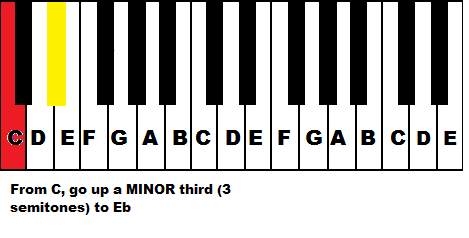
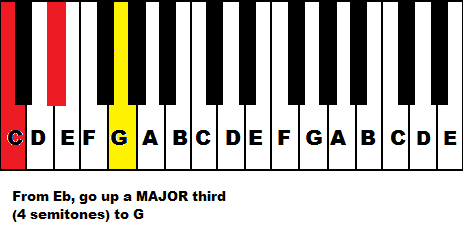
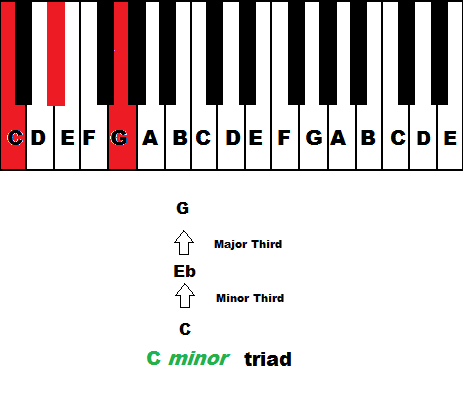
If you're particularly observant, you might have noticed that 2 out of the 3 notes of a major and minor chord are the same. The root (in this case, C) and the fifth (G) are the same in both major and minor. However, the third is E in a C major triad, but Eb in minor. In other words, the third of a minor chord is one semitone lower than the third of a major. This little trick may help you remember minor chords more easily if you don't want to go through the hassle of calculating those intervals every time.
But for your convenience, I'll list out all of the minor triads just like I did with major:
C Eb G
F Ab C
Bb Db F
Eb Gb Bb
Ab B Eb **
Db E Ab **
F# A C#
B D F#
E G B
A C E
D F A
G Bb D
** Pure music theorists would argue that the proper spellings for these chords should contain Cb instead of B, and Fb instead of E. Ignore them. Just use B and E. It's a lot easier.
Rather than add even more to this excruciatingly long entry, I'll provide an example of how these chords are used in a separate post. Stay tuned!
Major Triads
Remember major 3rd and minor 3rd intervals? You better, because those are essentially the foundation of chord structures. To form a major triad on any one note (for example, C), we first go up a major third from the root. C is the root, so going up a major third gives you E

That covers two notes of the triad. To get the last note, start on the second note (the E in this case), and go up a minor third

In conclusion:

As always, I encourage you to play out the notes so you can hear what the chords sound like. You can play multiple notes at one time using this virtual keyboard.
Since I'm such a nice guy, rather than making you figure out each major chord on your own, I'll just list them out. The first note of each triad is the name of the chord (e.g., F A C is an F major triad). Also remember that black keys can have two different note names (e.g., Bb and A# are the same, as is D# and Eb).
C E G
F A C
Bb D F
Eb G Bb
Ab C Eb
Db F Ab
F# A# C#
B D# F#
E G# B
A C# E
D F# A
G B D
________________________________________________________________
Got all that? I hope so. Because now it's time for minor triads!
________________________________________________________________
Minor Triads
There are a few ways in which you can think about minor triads. The "proper" way is to think about the intervals. Whereas a major triad contains a major third, and THEN a minor, a minor triad is the opposite. A minor triad starts with a minor third and ends with a major third.
In a nutshell:



If you're particularly observant, you might have noticed that 2 out of the 3 notes of a major and minor chord are the same. The root (in this case, C) and the fifth (G) are the same in both major and minor. However, the third is E in a C major triad, but Eb in minor. In other words, the third of a minor chord is one semitone lower than the third of a major. This little trick may help you remember minor chords more easily if you don't want to go through the hassle of calculating those intervals every time.
But for your convenience, I'll list out all of the minor triads just like I did with major:
C Eb G
F Ab C
Bb Db F
Eb Gb Bb
Ab B Eb **
Db E Ab **
F# A C#
B D F#
E G B
A C E
D F A
G Bb D
** Pure music theorists would argue that the proper spellings for these chords should contain Cb instead of B, and Fb instead of E. Ignore them. Just use B and E. It's a lot easier.
Rather than add even more to this excruciatingly long entry, I'll provide an example of how these chords are used in a separate post. Stay tuned!
Monday, March 7, 2011
Lesson #2 - Intervals
If you've hung around musical people before, you might have heard someone talk about "thirds," "fourths" or "fifths." These people are talking about intervals, a musical concept that can seem rather intimidating unless someone explains them to you. And that's exactly what I'm going to do!
You may recall me mentioning that the distance between any two consecutive notes on the piano is called a semitone. A semitone, also called a half-step, is just an interval, and every other interval is measured by its number of semitones. Before I explain this further, here's a list of all the intervals you will need to know:
1 Semitone - Minor Second
2 Semitones - Major Second
**3 Semitones - Minor Third**
**4 Semitones - Major Third**
**5 Semitones - Perfect Fourth**
6 Semitones - Tritone
**7 Semitones - Perfect Fifth**
8 Semitones - Minor Sixth
**9 Semitones - Major Sixth**
10 Semitones - Minor Seventh
11 Semitones - Major Seventh
**12 Semitones - Octave**
I've starred and bolded the ones that are important for now. Let's go over each of these individually:
Major Third
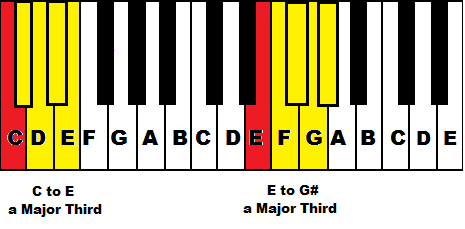
Remember that a major third is 4 semitones away from the starting note. C to E is a major third, and so is E to G# (because of the funky pairs of B/C and E/F).
Don't forget about the useful Virtual Keyboard so you can play the notes yourself to see what these intervals sound like.
Minor Third
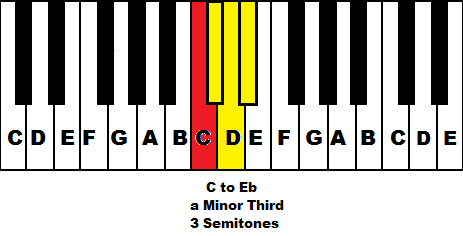
I decided to cover minor thirds after major thirds just because people generally cover major before minor when they learn music. Regardless, the concept is similar.
Minor thirds are 3 semitones away from their root notes. An Eb is 3 semitones above a C.
***Useful note: This will come up in the next lesson, but the third is the foundation of pretty much all chords. For example, a C chord is a C, a major third from C (which is E), and a minor third from E (which is G). Basically, if you can do thirds, you can do chords!**
Perfect Fourth and Fifths
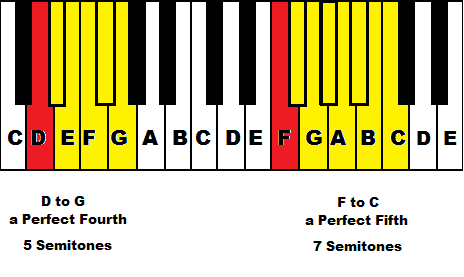
Fourths and Fifths are a little different. Unlike other intervals, fourths and fifths can never be major or minor, but cam only be perfect, augmented or diminished. Perfect fourths and fifth are the more commons ones, so let's just focus on those. As you can see, a note is a perfect fourth if it's 5 semitones away from the starting note and a perfect fifth if it's 7 semitones away.
Major Sixth
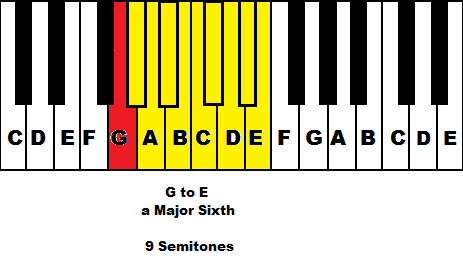
Self-explanatory at this point. 9 semitones will give you a major sixth.
Octave
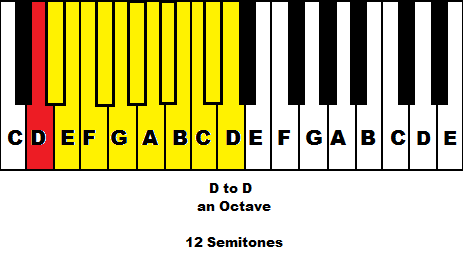
You can remember that an octave is 12 semitones, but the easiest way to remember is just that an octave is just the next instance of the same note on the piano (e.g., an octave from G is the next closest G in either direction).
There are a few other things I should note:
- The same interval from the same note in opposite directions will NOT yield the same pitch class. For example, a major sixth UP from C is an A, but a major sixth DOWN from C is an Eb.
- On the same note, in order to get to the same note going in one direction as the other, all you need to do is invert the interval and the quality. Here's what I mean:
If you go up a major sixth from C, you get an A. If you want to go DOWN to A from C, you invert the major sixth. To invert an interval, you subtract the number from 9 and invert the quality. Major and minor are inverses of each other, as are diminished and augmented (not covered here). Perfect stays perfect.
So, to invert the major sixth, major becomes minor, and then you subtract 6 from 9 (9 - 6 = 3). Therefore, the inverse of a major sixth is a minor third. In other words, going up a major sixth from C will yield the same pitch class as going down a minor third from C (A).
- Intervals from a minor second to an octave are simple intervals. Intervals above that are called compound intervals. To get the corresponding simple interval from a compound, simply subtract 7. For example, A major ninth is essentially the same thing as a major second (just separated by an additional octave).
Remember these intervals and simple tips, practice with them on a piano or the online keyboard, and you'll be able to not only play, but understand chords.
Next lesson: *guess what it is. Go on, guess*
CHORDS!!
You may recall me mentioning that the distance between any two consecutive notes on the piano is called a semitone. A semitone, also called a half-step, is just an interval, and every other interval is measured by its number of semitones. Before I explain this further, here's a list of all the intervals you will need to know:
1 Semitone - Minor Second
2 Semitones - Major Second
**3 Semitones - Minor Third**
**4 Semitones - Major Third**
**5 Semitones - Perfect Fourth**
6 Semitones - Tritone
**7 Semitones - Perfect Fifth**
8 Semitones - Minor Sixth
**9 Semitones - Major Sixth**
10 Semitones - Minor Seventh
11 Semitones - Major Seventh
**12 Semitones - Octave**
I've starred and bolded the ones that are important for now. Let's go over each of these individually:
Major Third

Remember that a major third is 4 semitones away from the starting note. C to E is a major third, and so is E to G# (because of the funky pairs of B/C and E/F).
Don't forget about the useful Virtual Keyboard so you can play the notes yourself to see what these intervals sound like.
Minor Third

I decided to cover minor thirds after major thirds just because people generally cover major before minor when they learn music. Regardless, the concept is similar.
Minor thirds are 3 semitones away from their root notes. An Eb is 3 semitones above a C.
***Useful note: This will come up in the next lesson, but the third is the foundation of pretty much all chords. For example, a C chord is a C, a major third from C (which is E), and a minor third from E (which is G). Basically, if you can do thirds, you can do chords!**
Perfect Fourth and Fifths

Fourths and Fifths are a little different. Unlike other intervals, fourths and fifths can never be major or minor, but cam only be perfect, augmented or diminished. Perfect fourths and fifth are the more commons ones, so let's just focus on those. As you can see, a note is a perfect fourth if it's 5 semitones away from the starting note and a perfect fifth if it's 7 semitones away.
Major Sixth

Self-explanatory at this point. 9 semitones will give you a major sixth.
Octave

You can remember that an octave is 12 semitones, but the easiest way to remember is just that an octave is just the next instance of the same note on the piano (e.g., an octave from G is the next closest G in either direction).
There are a few other things I should note:
- The same interval from the same note in opposite directions will NOT yield the same pitch class. For example, a major sixth UP from C is an A, but a major sixth DOWN from C is an Eb.
- On the same note, in order to get to the same note going in one direction as the other, all you need to do is invert the interval and the quality. Here's what I mean:
If you go up a major sixth from C, you get an A. If you want to go DOWN to A from C, you invert the major sixth. To invert an interval, you subtract the number from 9 and invert the quality. Major and minor are inverses of each other, as are diminished and augmented (not covered here). Perfect stays perfect.
So, to invert the major sixth, major becomes minor, and then you subtract 6 from 9 (9 - 6 = 3). Therefore, the inverse of a major sixth is a minor third. In other words, going up a major sixth from C will yield the same pitch class as going down a minor third from C (A).
- Intervals from a minor second to an octave are simple intervals. Intervals above that are called compound intervals. To get the corresponding simple interval from a compound, simply subtract 7. For example, A major ninth is essentially the same thing as a major second (just separated by an additional octave).
Remember these intervals and simple tips, practice with them on a piano or the online keyboard, and you'll be able to not only play, but understand chords.
Next lesson: *guess what it is. Go on, guess*
CHORDS!!
Saturday, February 12, 2011
Michael Jackson Cover!
No, I didn't do "Beat It" or "Billie Jean" or anything like that. I first heard "Hold My Hand" on the radio back in October, and I kind of liked it. Then, as with many other songs, I heard it more, and I liked it more. Then I heard it even more, and I REALLY liked it. You can see where I'm going with this.
I haven't done an a cappella cover since "Nothing On You" by B.O.B. back in June, so this one was a lot of fun to do!
So here it is. The result of multi-track layerings of my voice + a one-day Flipcam rental + amazing audio and video editing software + 2-3 hours of work per day over 4 days:
I haven't done an a cappella cover since "Nothing On You" by B.O.B. back in June, so this one was a lot of fun to do!
So here it is. The result of multi-track layerings of my voice + a one-day Flipcam rental + amazing audio and video editing software + 2-3 hours of work per day over 4 days:
Subscribe to:
Posts (Atom)
